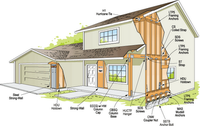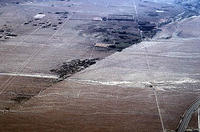-
Sea level rise or not, coastal development in south Florida is booming
Miami and Miami Beach are both considered ground zero for the challenges posed by climate change, as both cities will experience considerable sea level rise by mid-century. Constant flooding will become the norm as high tides reach shores, posing a threat to property and human life. As discouraging as the future may seem for South Florida, residents, real estate investors, and companies are increasing their investments in the area.
-
-
Retrofitting old buildings to make them earthquake safe
Non-ductile reinforced concrete buildings are among the most common structures in the United States. They are also among the most deadly. Structures built prior to the 1950s in California and prior to the 1980s in the central and southeastern United States were typically not designed with proper details to perform adequately during earthquakes. Through a grant provided by the National Science Foundation, researchers are testing retrofits that potentially can make these buildings safer and more secure.
-
-
Global surge of great earthquakes from 2004 to 2014: Implications for Cascadia
The last ten years have been a remarkable time for great earthquakes. Since December 2004 there have been no less than eighteen quakes of Mw8.0 or greater — a rate of more than twice that seen from 1900 to mid-2004. Hundreds of thousands of lives have been lost and massive damage has resulted from these great earthquakes. As devastating as such events can be, however, these recent great quakes have come with a silver lining: They coincide with unprecedented advances in technological and scientific capacity for learning from them.
-
-
Getting the salt out
The boom in oil and gas produced through hydraulic fracturing, or fracking, is seen as a boon for meeting U.S. energy needs. But one byproduct of the process is millions of gallons of water that’s much saltier than seawater, after leaching salts from rocks deep below the surface. Study shows electrodialysis can provide cost-effective treatment of salty water from fracked wells.
-
-
California earthquake early warning system set to go online in 2016
Disaster management officials in California are reporting that a new earthquake early-warning system will be online in the state within the next two years. A bill mandating the system was passed in January under Senate Bill 135, requiring the state’s Office of Emergency Services (OES) to develop a statewide system that can alert Californians before dangerous shaking with a ten second window. The funding for the project is $80 million for the first five years.
-
-
Engineers build, test earthquake-resistant house

Residential homes already do a good job of keeping the people inside safe when a temblor hits. Earthquakes, however, typically do a lot of minor structural damage. For example, after the 1994 Northridge quake, the majority of the $25.6 billion in repair costs paid for fixes to 500,000 residential structures. Most of those homes were not destroyed, but nonetheless thousands of families had to find a new place to live while their houses were repaired. Twenty-five years after the 1989 Loma Prieta earthquake, Stanford engineers have built and tested an earthquake-resistant house that stayed staunchly upright even as it shook at three times the intensity of that destructive temblor. The engineers developed inexpensive design modifications that could be incorporated into new homes to reduce damage in an earthquake.
-
-
A boom in global natural gas, by itself, will not slow climate change
A new analysis of global energy use, economics, and the climate shows that without new climate policies, expanding the current bounty of inexpensive natural gas alone would not slow the growth of global greenhouse gas emissions worldwide over the long term. Because natural gas emits half the carbon dioxide of coal, many people hoped the recent natural gas boom could help slow climate change — and according to government analyses, natural gas did contribute partially to a decline in U.S. carbon dioxide emissions between 2007 and 2012. In the long run, however, according to this study, a global abundance of inexpensive natural gas would compete with all energy sources — not just higher-emitting coal, but also lower-emitting nuclear and renewable energy technologies such as wind and solar. Inexpensive natural gas would also accelerate economic growth and expand overall energy use.
-
-
New facility for hurricane research to study why some storms intensify so quickly
It still astonishes meteorologists. In the span of just twenty-four hours, Hurricane Wilma, the twenty-second named storm of the record-breaking 2005 Atlantic hurricane season, intensified from a tropical cyclone to a Category 5 hurricane — its wind speed soaring from 70 to 175 mph. As remarkable as Wilma’s rapid intensification was, however, it is not the only case of a storm muscling up at warp speed. As Hurricane Charley approached Florida’s west coast in 2004, its sustained winds jumped from 110 to 150 mph in only three hours. In 2007 Felix strengthened from a meager tropical depression to a Category 5 hurricane in fifty-one hours. This could all change soon now that the University of Miami’s Rosenstiel School of Marine and Atmospheric Science has opened its Marine Technology and Life Sciences Seawater Complex, a $50 million facility that houses a 38,000-gallon, 75-foot-long tank into which researchers pump seawater to study how the ocean and atmosphere interact — the critical air-sea interface that could tell us why some storms intensify so quickly.
-
-
Floating cities increasingly attractive prospect in the face of sea level rise, floods

More and more urban planners and disaster managers are asking the question: “Has the time come for floating cities?” Experts say thatin the face of climate change-driven sea level rise and shifting weather patterns poised seriously to impact many cities over the course of the next decades, the option of having cities that can accommodate shifting tides is making more and more sense.
-
-
Hydraulic fracturing caused earthquakes in Ohio
Hydraulic fracturing triggered a series of small earthquakes in 2013 on a previously unmapped fault in Harrison County, Ohio, according to a new study. This series of earthquakes is the first known instance of seismicity in the area. Hydraulic fracturing, or fracking, is a method for extracting gas and oil from shale rock by injecting a high-pressure water mixture directed at the rock to release the gas inside. The process of hydraulic fracturing involves injecting water, sand and chemicals into the rock under high pressure to create cracks. The process of cracking rocks results in micro- earthquakes.
-
-
Sections of the San Andreas Fault system in San Francisco Bay Area are locked, overdue

The earthquake cycle reflects the accumulation of strain on a fault, its release as slip, and its re-accumulation and re-release. Fault creep is the slip and slow release of strain in the uppermost part of the Earth’s crust that occurs on some faults between large earthquakes, when much greater stress is released in only seconds. Where no fault creep occurs, a fault is considered locked and stress will build until it is released by an earthquake. Four urban sections of the San Andreas Fault system in Northern California have stored enough energy to produce major earthquakes, according to a new study that measures fault creep. Three fault sections — Hayward, Rodgers Creek, and Green Valley — are nearing or past their average recurrence interval, according to the study.
-
-
In worst-case scenario, sea level would rise 1.8 meters
The climate is getting warmer, the ice sheets are melting and sea levels are rising — but how much? The report of the UN’s Intergovernmental Panel on Climate Change (IPCC) in 2013 was based on the best available estimates of future sea levels, but the panel was not able to come up with an upper limit for sea level rise within this century. Now researchers have calculated the risk for a worst-case scenario. The results indicate that at worst, the sea level would rise a maximum of 1.8 meters – but the much more likely rise in sea level would be around 80 cm.
-
-
Bay Area’s infrastructure more resilient, but a major tremor would paralyze region’s economy
Twenty-five years ago, the San Francisco Bay Area suffered the 6.9 magnitude Loma Prieta earthquake, which killed sixty-three people, injured 3,700, destroyed 366 businesses and 11,000 homes, and caused $6 billion in property damage. Since then, bridges and roads have been rebuilt to withstand more powerful quakes, but seismic safety experts say more could be done to protect property and human life. A major earthquake is not likely completely to destroy the Golden Gate Bridge or other major infrastructure developments, but the Bay Area’s $535 billion a year economy will come to a halt for months and even years due to weakened critical infrastructure.
-
-
U.S. military must be ready for climate change: Hagel
Climate change is a threat multiplier, and the U.S. Defense Department is taking steps to incorporate this issue into all planning, Defense Secretary Chuck Hagel said in Peru Monday. Climate change has the potential to exacerbate many of the challenges the world already confronts, from the spread of infectious diseases to spurring armed conflicts, Hagel said at the Conference of the Defense Ministers of the Americas. Hagel announced a Defense Department Climate Change Adaptation Roadmap during his speech. The roadmap is based on science, he said, and describes the effects of climate change on DoD’s missions and responsibilities.
-
-
15 years from now, our impact on regional sea level will be clear

Coastal communities and industries require information on regional sea-level change to develop strategies for reducing the risk to population, infrastructure and the environment. This requires modeling projections of sea-level rise, estimating the costs and benefits of adaptation options, and understanding the impacts on coastal ecosystems. Inundation maps that can be used to identify areas that are most vulnerable to rising sea levels are particularly valuable. Adaptation measures may include land-use planning such as preventing building in low lying areas, increasing or maintaining a vegetated coastal margin that serves as a buffer zone against extreme sea levels, or using protective sea walls in the long run if certain sea level rise thresholds are exceeded.
-
More headlines
The long view
Water Wars: A Historic Agreement Between Mexico and US Is Ramping Up Border Tension
As climate change drives rising temperatures and changes in rainfall, Mexico and the US are in the middle of a conflict over water, putting an additional strain on their relationship. Partly due to constant droughts, Mexico has struggled to maintain its water deliveries for much of the last 25 years, deliveries to which it is obligated by a 1944 water-sharing agreement between the two countries.
Trump Is Fast-Tracking New Coal Mines — Even When They Don’t Make Economic Sense
In Appalachian Tennessee, mines shut down and couldn’t pay their debts. Now a new one is opening under the guise of an “energy emergency.”
Smaller Nuclear Reactors Spark Renewed Interest in a Once-Shunned Energy Source
In the past two years, half the states have taken action to promote nuclear power, from creating nuclear task forces to integrating nuclear into long-term energy plans.
Keeping the Lights on with Nuclear Waste: Radiochemistry Transforms Nuclear Waste into Strategic Materials
How UNLV radiochemistry is pioneering the future of energy in the Southwest by salvaging strategic materials from nuclear dumps –and making it safe.
Model Predicts Long-Term Effects of Nuclear Waste on Underground Disposal Systems
The simulations matched results from an underground lab experiment in Switzerland, suggesting modeling could be used to validate the safety of nuclear disposal sites.
